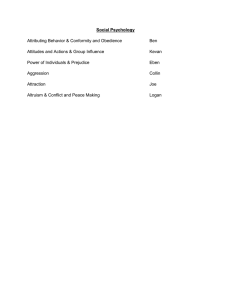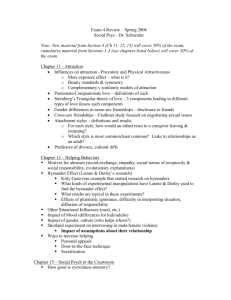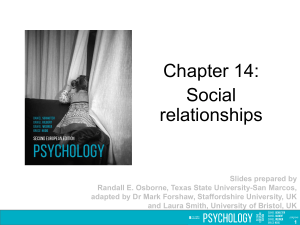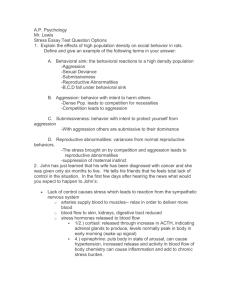Social Psychology
advertisement
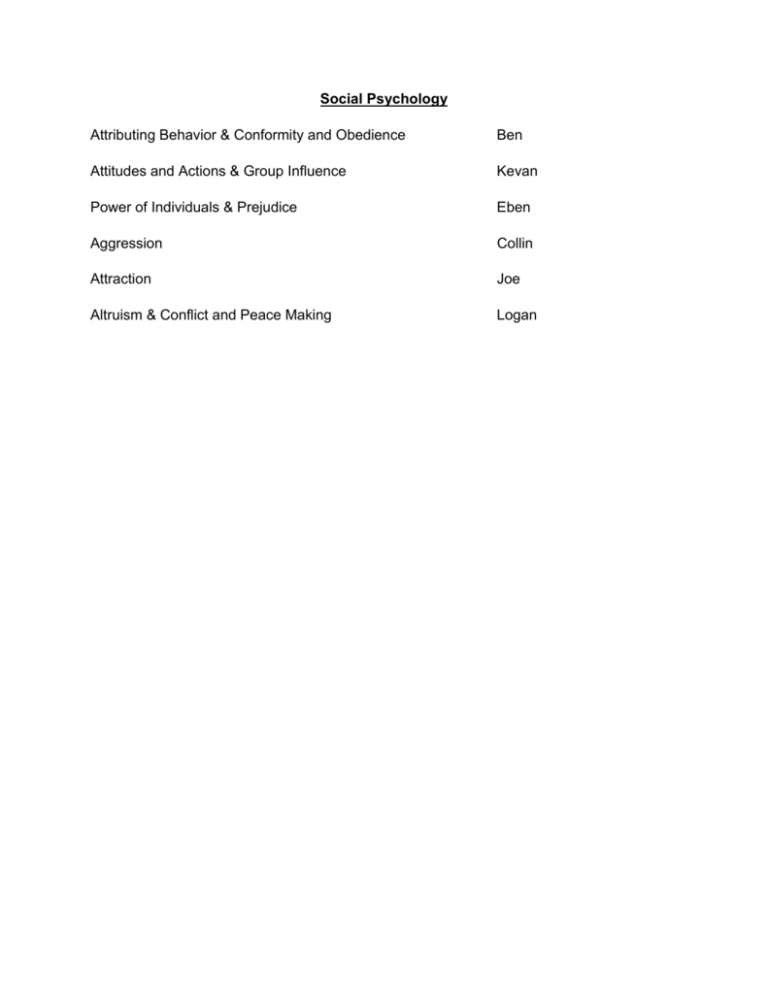
Social Psychology Attributing Behavior & Conformity and Obedience Ben Attitudes and Actions & Group Influence Kevan Power of Individuals & Prejudice Eben Aggression Collin Attraction Joe Altruism & Conflict and Peace Making Logan Altruism & Conflict and Peace Making altruism: unselfish regard for the welfare of others bystander effect: the tendency for any given bystander to be less likely to give aid if other bystanders are present (Kitty Genovese rape and murder) John Darley and Bibb Latane: found that people will only help after three steps are taken; noticing the incident, interpreting it as an emergency, and finally assuming responsibility for helping. At each of these steps, they found that the presence of bystanders turns people away from these steps that lead to helping. diffusion of responsibility: when more people share responsibility for helping, any single listener will be less likely to help. best odds of our helping someone occur when: the person appears to need and deserve help the person is in some way similar to us we have just observed someone else being helpful we are not in a hurry we are in a small town or rural area we are feeling guilty we are focused on others and not preoccupied we are in a good mood social exchange theory: the theory that our social behavior is an exchange process, the aim of which is to maximize benefits and minimize costs. reciprocity norm: an expectation that people will help, not hurt, those who have helped them social-responsibility norm: an expectation that people will help those dependent upon them (Gallup surveys report those that attend religious services volunteer more for the sick and poor) conflict: a perceived incompatibility of actions, goals, or ideas social trap: a situation in which the conflicting parties, by each rationally pursuing their selfinterest, become caught in mutually destructive behavior mirror-image perceptions: mutual views often held by conflicting people, as when each side sees itself as ethical and peaceful and views the other side as evil and aggressive superordinate goals: shared goals that override differences among people and require their cooperation GRIT: Graduated and Reciprocated Initiatives in Tension-Reduction, a strategy designed to decrease international tensions Attitudes and Actions: • Attitudes affect Actions o Central Route Persuasion: when a person is naturally analytical, or involved with the issue o Peripheral Route: when a person makes a snap judgement (i.e because they see a respectable person do something) *Central Route Persuasion is more likely to change a person’s behavior, because it is less superficial than Peripheral Route* • Actions affect Attitudes o Foot-in-the-Door Phenomenon: the tendency for people to agree to much larger actions if they have agreed to do smaller/trivial tasks earlier o Role-Playing: Once receiving a new role in society, subconsciously people strive to meet the demands and standards of following the social prescription o Cognitive Dissonance: when our actions and attitudes do not coincide Group Influence: • • • Individual Behavior in the Presence of Others o Social Facilitation: in the presence of others, stronger responses on simple or well learned tasks o Social Loafing: in a group, humans have a tendency not to try as hard as they would if they were by themselves o Deindividualization: loss of self-awareness and self-restraint when in a group Effects of Group Interaction o Group Polarization: if a group is like-minded, discussion strengthens its opinions o Groupthink: the mode of thinking that occurs when the desire for harmony in a decision-making group overrides a realistic appraisal of alternatives Power of Individuals When one person chooses to go against the majority, others tend to follow Attributing Behavior & Conformity and Obedience Attribution theory- The theory that we explain when someone’s behavior by crediting either the situation or the person’s disposition. Fundamental attribution error- The tendency for observers, when analyzing another’s behavior, to underestimate the impact of the situation and to overestimate the impact of personal disposition. Conformity- Adjusting one’s behavior or thinking to coincide with a group standard. Soloman Asch- Asch’s conformity experiments, in which he had a group of five confederates and one participant. Asch had them look at lines and answer which lines were the same length. After a little bit into the trial the confederates all chose the wrong answers on some questions to see if the participant would conform. Most of the time they conformed . Normative social influence- influence resulting from a person’s desire to gain approval or avoid disapproval. Informational social influence- Influence resulting from one’s willingness to accept others’ opinions about reality. Stanley Milgram- Milgram did the obedience studies at Yale University. The experiment involved the teacher (participant), student (confederate), and an experimenter who told the teacher what to do. The teacher was to “teach” the student a list of words and then test the student on them. If the student got it wrong the teacher would shock the student. The shocks went up to 450 volts. 63% went all the way to the highest voltage during the study. Aggression any physical or verbal behavior intended to hurt or destroy, whether done reactively out of hostility or proactively as a calculated means to an end. - Aggression is a learned instinct - Biology influences aggression - Testosterone greatly affects aggression - Alcohol increases aggression both psychologically and biologically - Social exclusion is a large cause of aggressive behavior - Sexual aggression is greatly increased by regular viewing of X-Rated material - All forms of media offer social cues on how to act, often violent Studies - Study by Miles & Carey show twins often share similar violence levels - Moyer found that there are neural triggers to aggression - Mazzer & Booth testosterone not only increases aggression, but aggression increases testosterone - Greenfield found drinking leads to 4/10 violent crimes and ¾ acts of spousal abuse - Anderson & Anderson found violence increase with temperature - Young males raised without a father at home have nearly 2x the incarceration rate (Harper & Mclanahan) - Volunteers subjected to hatefull songs were more likely to act/think hostile towards those targeted by the lyrics (Fischer & Greitemeyer) - Violent video games can increase general aggressive tendencies Terms frustration-aggression principle - frustration creates anger, which may in some people generate aggression, especially in the presence of an aggressive cue Attraction The Psychology of Attraction Proximity Within limits, familiarity breeds fondness. People are more likely to like people who are close to them, whether they live in the same neighborhood or sit next to each other in class. Mere exposure effect - the phenomenon that repeated exposure to novel stimuli increases liking of them. Physical Attractiveness A person’s physical attractiveness plays the biggest role on a person’s first impression. We perceive attractive people to be healthier, happier, more sensitive, more successful, and more socially skilled, though not more honest or compassionate. People’s attractiveness is unrelated to their self-esteem and happiness. Judgements of attractiveness are relative; beauty is in the eye of the culture. However, men judge women to be more attractive if they have a youthful appearance and women judge men to be more attractive if they seem mature, dominant, and affluent. People like average sized body parts, such as noses and legs, as well as people with symmetrical faces and bodies. Attractiveness also depends on our feelings about the person. If someone believes that a person has appealing traits, like being nice and funny, people will perceive that person to be more attractive. Similarity Opposite do not attract. The more alike people are, the more their liking endures. Reward Theory of Attraction - We will like those whose behavior is rewarding to us and that we will continue relationships that offer more rewards than costs. Reward Theory of Attraction basically sums up everything above on attraction. When a person lives in close proximity with someone else, it costs less time and effort to develop the friendship and enjoy its benefits. Attractive people are aesthetically pleasing, and associating with them can be socially rewarding. Those with similar views reward us by validating our own. Romantic Love Passionate Love Passionate Love - an aroused state of intense positive absorption in another, usually present at the beginning of a love relationship. The Two Factor Theory of Emotion helps us understand this intense positive absorption in another. The theory assumes that (1) emotions have two ingredients - physical arousal plus cognitive appraisal - and that (2) arousal from any source can enhance one emotion or another, depending on how we interpret and label the arousal. Companionate Love Companionate Love - The deep affectionate attachment we feel for those with whom our lives are intertwined. As love matures it becomes a steadier companionate love. Passionate love often produces children, whose survival is aided by the parents’ waning obsession with one another. Equity - A condition in which people receive from a relationship in proportion to what they give to it. Equity is one key to a gratifying and enduring relationship. Self-Disclosure - Revealing intimate aspects of oneself to others. Self-disclosure is another vital ingredient of loving relationships. Intimacy can also grow from pausing to ponder and write our feelings.
